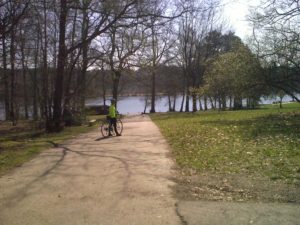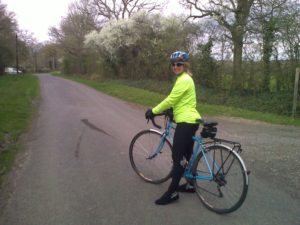A “staycation”, Barnes style
On Good Friday, Tom and I decided to do a long cycle ride to West Sussex, as Tom was unable to take any days off work to enable us to do something more exciting like the Wales end to end! This type of ride seems to have become a feature in our household; each time I have a school holiday, Tom manages to take one day off (!) or to make use of a bank holiday, so that we can do an interesting ride.
I planned our route a few days earlier, with the help (a) of an interesting club ride on Tuesday thanks to Des and (b) of cycle-route.com, which we have used before for nice jaunts in West Sussex. Tom took these google maps routes and downloaded them into our home-made car/bicycle sat nav set-up, and we were ready to roll.
The first section of our chosen route took us seventeen miles to Gatwick for breakfast at Charlie’s Deli, a kind of upmarket greasy spoon, and a favourite of ours since discovering it, extremely tired and hungry, after cycling from Tunbridge Wells to Gatwick a couple of years ago. We had a very pleasant ride fairly early in the morning, along lots of bridle paths (route 21), and with little traffic on the roads.
After Tom enjoyed his favoured “Full English” and I nibbled on a more modest English muffin, we headed off on the second section of our route, a fifteen mile ride southwest to a town called Southwater. We had managed to plan a route which took us well away from the busy areas of Crawley and Horsham, through some lovely country areas. Features of the route included a ride through beautiful Tilgate Park with its lovely lake. We hadn’t realised there was such a lovely park in this area, and discovered that it has miles of woodland walks and waterways, and has many great activities for families. This was clear, as the park was full of families enjoying a day out, and the car parks were full to bursting.
We also enjoyed riding past the Hammer Ponds to the east of Horsham. We discovered that, while the areas around these ponds are very scenic and tranquil, their historical origins are grimly practical. ‘Hammer’ ponds are not natural lakes but dammed streams and rivers, crucial to the Tudor and Stuart iron industry that was established within the High Weald of Kent and Sussex. We were surprised to discover that the Weald was a major iron-producing region long before the Romans arrived, due to its abundant clay ironstone deposits. Water was essential for cooling the iron and the High Weald has many swift streams in deep, densely wooded valleys, known locally as ‘ghylls’, which eventually played a pivotal role. From the end of the 15th century new developments in the industry required many of these waters to be impounded, and the heads of water that built up were used to turn waterwheels. These powered the furnace bellows, and also the huge forge hammers which pounded the new pig iron into refined bars. Hence Furnace and Hammer Ponds.
We didn’t stop at Southwater, but continued immediately onto our chosen “cycle-route.com” ride; the Southwater to Steyning Loop, a twenty-five mile ride through typical peaceful West Sussex countryside. This area of England is a particular favourite of ours for riding, and we were not disappointed on this occasion. As well as the pleasure of cycling through such charming villages and country areas, was the delight of a glorious, hot sunny Spring day. What bliss! To add to our pleasure, as we cycled into a little village with the unusual name of Dial Post, we noticed a pleasant green with picnic tables on the right hand side of the ride, with a charming pub directly opposite. What more could we want? Tom ventured into the pub to fetch liquid refreshment, while I set out the picnic we had brought with us. After feasting on salmon sandwiches, we had a short snooze in the sun, before continuing on our way. Half-way around the route, we noticed a sign to Chanctonbury Ring, and feeling curious, cycled a mile uphill to investigate. Sadly, upon reaching the end, we discovered that we would have to push our bikes uphill on a steep gravel path for a considerable distance to actually view the Ring, so had to abandon the scheme and cycle back to our route.
We enjoyed a cup of tea at a pub just prior to our starting point of Southwater, where we were entertained (or possibly musically appalled) by the opposing claims of a jazz singer outside and pop music inside. Following this, it was time to start the long jaunt home. It was now 5pm, and we had about thirty-five miles yet to ride. We cycled southeast to Turner’s Hill, and despite having already covered sixty miles, did not find the route very taxing, as it was rather flat. It was very pleasant to cycle at that time of day without much traffic, as it was a lovely evening. By the time we reached the Copthorne area, we were starving, and stopped at the Hedgehog Inn for dinner. This pub has special significance for us, as we first discovered it in 2007, when we travelled from New Zealand to the UK to cycle from London to Paris on our tandem!
We arrived home at 10pm, weary of leg, but happy with the day, and the ninety-two miles didn’t put us off venturing to ride to Weybridge the following day (a mere fifty-odd miles) to visit Tom’s 86 year old uncle!





I really enjoyed your article, full of interesting info about the ride, places and local history. I also found out about the Weald iron industry thru cycling, and lots of other things about our area and it’s history. Another area famous for it’s hammer ponds is Lingfield and the surrounding area. The water there being mainly supplied by the Kent Brook which forms the local boundary where Kent, Sussex and Surrey meet.
For those who are not familiar with cycle-route.com, click here http://www.cycle-route.com/routes/Circular,_Dolgellau_to_Dysynni_Valley-Cycle-Route-6334.html and you will find a route sent by a person identified as “anerley bicycle club”. I wonder who that could be!